#c: makarius
Text

Makarius sketches
8 notes
·
View notes
Photo

Untitled (Avellaneda Ferry, La Boca), Photo by Sameer Makarius, c. 1959
84 notes
·
View notes
Text
References
Anderson, D., & Anderson, L. A. (2010). Beyond change management: How to achieve breakthrough results through conscious change leadership. San Francisco, CA: John Wiley & Sons.
Barlow, J. B., & Dennis, A. R. (2016). Not as smart as we think: A study of collective intelligence in virtual groups. Journal of Management Information Systems, 33(3), 684-712.
Bartel, C. A., Wrzesniewski, A., & Wiesenfeld, B. M. (2012). Knowing where you stand: Physical isolation, perceived respect, and organizational identification among virtual employees. Organization Science, 23(3), 743-757.
Blustein, D. L. (2006). The psychology of working: A new perspective for career development, counseling, and public policy. New York, NY: Routledge.
Brazzel, M. (2014). Organization change theories and models. In B. B. Jones & M. Brazzel (Eds.), NLT Handbook of organization development and change: Principles, practices and perspectives (255-282). San Francisco, CA: Somerset Pfieffer.
Cain, S. (2013). Quiet: The power of introverts in a world that can’t stop talking. New York, NY: Random House.
Dede, C. (2005). Planning for neomillennial learning styles: Implications for investments in technology and faculty. In J. Oblinger and D. Oblinger (Eds.), Educating the next generation (pp. 226-247). Boulder, CO: EDUCAUSE Publishers.
Dekker, D. M., Rutte, C. G., & Van den Berg, P. T. (2008). Cultural differences in the perception of critical interaction behaviors in global virtual teams. International Journal of Intercultural Relations, 32, 441-452. doi:10.1016/j.ijintrel.2008.06.003
DeSanctis, G., & Poole, M. S. (1994). Capturing the complexity in advanced technology use: Adaptive structuration theory. Organization Science, 5(2), 121-147.
Dube, L., & Robey, D. (2009). Surviving the paradoxes of virtual teamwork. Information Systems Journal, 19(1), 3-30.
Dulebohn, J. H., & Hoch, J. E. (2017). Virtual teams in organizations. Human Resource Management Review 27(4), 569-574.
Earley, P. C., & Ang, S. (2003). Cultural intelligence: Individual interactions across cultures. Standford, CA: Stanford University Press.
Felder, R. M., & Soloman, B. A. (n.d.) Learning styles and strategies. Retrieved from www2.ncsu.edu:8010/unity/lockers/users/f/felder/public/ILSdir/styles.htm
Frohman, A.L. (1997). Igniting organizational change from below: The power of personal initiative. Organizational Dynamics, 25(3), 39-53.
Gardner, H. (1983). Frames of mind: The theory of multiple intelligences. New York, NY: Basic Books.
Gardner, H. (1997). Is there a moral intelligence? In M. Runco (Ed.) The creativity research handbook. Cresskill, NJ: Hampton Press.
Gibson, C. B., & Gibbs, J. L. (2006). Unpacking the concept of virtuality: The effects of geographic dispersion, electronic dependence, dynamic structure, and national diversity on team innovation. Administrative Science Quarterly, 51, 451-495.
Gill, R. (2003). Change management – or – Change leadership? Journal of Change Management, 3(4), 307-318.
Godart, C., Bouthier, C., Canalda, P., Charoy, F., Molli, P., Perrin, O., Saliou, H., Bignon, J. C., Halin, G., & Malcurat, O. (2001). Asynchronous coordination of virtual teams in creative applications (co-design or co-engineering): Requirements and design criteria. Australian Computer Science Communications, 23(6), 135-142.
Goleman, D. (1995). Emotional intelligence: Why it can matter more than IQ.London, UK: Bloomsbury Publishing.
Guimond, S. (2016). The effect of narrative format and target race attitude change about poverty in college students. (Honors thesis, Ball State University). Retrieved fromhttp://cardinalscholar.bsu.edu/bitstream/handle/123456789/200412/A374_2016GuimondSavannah-opt.pdf?sequence=1
Gupta, P. (2017, April 6). Focus on results not tasks. [Video post]. Retrieved from https://www.youtube.com/watch?v=vCokpMsQJsk
Hackman, J. R. (1987). The design of work teams. In J. Lorsch (Ed.), Handbook of organizational behavior (pp. 315-342).Englewood Cliffs, NJ: Prentice-Hall.
Hartman, T. (2014). Chakra wisdom oracle toolkit: A 52 week journey of self-discovery with the lost fables. London, UK: Watkins.
Hechler, S., Neyer, F. J., & Kessler, T. (2016). The infamous among us: Enhanced reputational memory for uncooperative ingroup members. Cognition, 157, 1-13.
Henderson, L. S., Stackman, R. W., & Lindekilde, R. (2016). The centrality of communication norm alignment, role clarity, and trust in global project teams. International Journal of Project Management, 34(8), 1717-1730.
Hertel, G., Geister, S., & Konradt, U. (2005). Managing virtual teams: A review of current empirical research. Human Resource Management Review, 15, 69-95.
Hildebrandt, M., Jehle, L., & Meister, S. (2013). Closeness at A Distance: Leading Virtual Groups to High Performance. Faringdon, UK: Libri Publishing.
Hoch, J. E., & Kozlowski, S. W. (2014). Leading virtual teams: Hierarchical leadership, structural supports, and shared team leadership. Journal of Applied Psychology, 99(3), 390-403.
Hofstede, G. (1980). Culture’s consequences: International differences in work-related values. Newbury Park, CA: Sage.
Huysman, M. H., & de Wit, D. H. (2013). Knowledge sharing in practice.Dordrecht, the Netherlands: Kluwer Academic Publishers.
Ioanid, A., Zarzu, C., & Scarlat, C. (2014). Communicating successfully when managing multicultural teams. Sea: Practical Application of Science, 2(3), 349-354.
Irving, J. A. (2010). Educating global leaders: Exploring intercultural competence in leadership education. Journal of International Business & Cultural Studies, 3, 1-14.
Janssens, M., & Brett, J. M. (2006). Cultural intelligence in global teams: A fusion model of collaboration. Group & Organization Management, 31(1), 124-153.
Jarvenpaa, S. L., & Leidner, D. E. (1998). Communication and trust in global virtual teams. Journal of Computer‐Mediated Communication, 3(4). doi: 10.1111/j.1083-6101.1998.tb00080.x
Jokinen, T. (2005). Global leadership competencies: A review and discussion. Journal of European Industrial Training, 29(2/3), 199-216.
Jones, B. B. (2014). A framework for change: Capacity, competency, and capability. In B. B. Jones & M. Brazzel (Eds.), NLT Handbook of organization development and change: Principles, practices and perspectives (233-254). San Francisco, CA: Somerset Pfieffer.
Karp, H. B. (1980) Team building from a Gestalt perspective. In J. W. Pfeiffer and J. E. Jones (Eds.), The 1980 Annual Handbook for Group Facilitators. San Diego, CA: University Associates.
Katz, L. (2015). Book review: Hildebrandt, Jehle, Meister, with Skoruppa closeness at a distance. Houston, TX: Leadership Crossroads.
Lennick, D., & Kiel, F. (2007). Moral intelligence: Enhancing business performance and leadership success. Upper Saddle River, NJ: Pearson Prentice Hall.
Lewin, K. (1997). Frontiers in group dynamics. In D. Cartwright (ed.), Resolving social conflicts & field theory in social science (301-336). Washington, DC: American Psychological Association.
Ling, B. (2015, August 26). Intro: Processes and procedures. [Video post]. Retrieved from https://www.youtube.com/watch?v=4e16OQRYtXU&feature=youtu.be
Lojeski, K. S., & Reilly, R. R. (2008). Uniting the virtual workforce: Transforming leadership and innovation in the globally integrated enterprise. Hoboken, NJ: John Wiley & Sons.
Makarius, E., & Larson, B. (2017). Changing the perspective of virtual work: Building virtual intelligence at the individual level. The Academy of Management Perspectives, 31(2), 159–178. doi: 10.5465/amp.2014.0120
Manole, I. (2014). Virtual teams and E-leadership in the context of competitive environment – literature review. Journal of Economic Development, Environment and People, 3(3), 72-76.
Manz, C. C. (1986). Self-leadership: Toward an expanded theory of self-influence processes in organizations. Academy of Management Review, 11(3), 585-600.
Martinic, A., Fertalj, K., & Kalpic, D. (2012). Methodological framework for virtual team project management. International Journal of Innovation, Management and Technology, 3(6), 702.
Martins, L. L., Gilson, L. L., & Maynard, M. T. (2004). Virtual teams: What do we know and where do we go from here? Journal of Management, 30(6), 805-835.
McCallum, J. (2013). Followership: The other side of leadership. Retrieved from
https://iveybusinessjournal.com/publication/followership-the-other-side-of-leadership/
McGuire, D., Garavan, T. N., Cunningham, J., & Duffy, G. (2016). The use of imagery in the campaign speeches of Barack Hussein Obama and John McCain during the 2008 US presidential election. Leadership & Organization Development Journal, 37(4), 430-449.
Meyer, E. (2010, August 19). The four keys to success with virtual teams. Retrieved from https://www.forbes.com/2010/08/19/virtual-teams-meetings-leadership-managing-cooperation.html
Miller, E. (Dec. 1998). A note on the protomental system and “groupishness”: Bion’s basic assumptions revisited. Human Relations, 51(13), 1495-1509.
Montoya-Weiss, M., Massey, A., & Song, M. (2001). Getting it together: Temporal coordination and conflict management in global virtual teams. The Academy of Management Journal, 44(6), 1251-1262.
Mortensen, M., Caya, O., Pinsonneault, A. (2009). Virtual teams demystified: An integrative
framework for understanding virtual teams and a synthesis of research. MIT Sloan School Working Paper 4738-09.
Nandhakumar, J., & Baskerville, R. (2006). Durability of online team working: Patterns of trust. Information Technology & People, 19(4), 371-389.
Poole, M. S. & Hollingshead, A. B., Editors. (2005). Theories of small groups: Interdisciplinary perspectives. Thousand Oaks, CA: Sage Publications.
Quinn, R. E., Spreitzer, G. M., & Brown, M. V. (2000). Changing others through changing ourselves: The transformation of human systems. Journal of Management Inquiry, 9(2), 147-164.
Schwartz, D. (2007). Integrating knowledge transfer and computer-mediated communication: Categorizing barriers and possible responses. Knowledge Management Research & Practice, 5(4), 249-259.
Snellman, C. L. (2014). Virtual teams: Opportunities and challenges for e-leaders. Procedia Social and Behavioral Sciences, 1(10), 1251-1261.
Stern, W. (1912). The psychological methods of intelligence testing. Baltimore, MD: Warwick and York.
Symons, J., & Stenzel, C. (2007). Virtually borderless: An examination of culture in virtual teaming. Journal of General Management, 32(3), 1-17.
Thorndike, R. L., & Stein, S. (1937). An evaluation of the attempts to measure social intelligence. Psychological Bulletin, 34(5), 275.
Tubbs, S. L., & Schulz, E. (2006). Exploring a taxonomy of global leadership competencies and meta-competencies Journal of American Academy of Business, Cambridge, 8(2), 29-34.
Tuckman, B. (1965). Developmental sequence in small groups. Psychological Bulletin 63(6): 384–99.
Vanzant, I. (2015). Trust: Mastering the four essential trusts. Charlsbad, CA: SmileyBooks.
Vázquez, A., Yzerbyt, V., Dovidio, J. F., & Gómez, Á. (2016). How we think they see us? Valence and difficulty of retrieval as moderators of the effect of meta‐stereotype activation on intergroup orientations. International Journal of Psychology, 1-9. doi: 10.1002/ijop.12260
Velpic. (2016, September 4). Knowledge sharing benefits. In R. Francis (Ed.) Webinar video recap & deck: Knowledge sharing in the workplace [Slide 13]. Retrieved from https://www.slideshare.net/VelpicLimited/knowledge-sharing-in-the-workplace
Wilson, J. M., Boyer O'Leary, M., Metiu, A., & Jett, Q. R. (2008). Perceived proximity in virtual work: Explaining the paradox of far-but-close. Organization Studies, 29(7), 979-1002.
Wpbeginner. (20 September 2017). How to choose the best blogging platform in 2017 (Compared). Retrieved from http://www.wpbeginner.com/beginners-guide/how-to-choose-the-best-blogging-platform/
Zakaria, N., Amelinckx, A., & Wilemon, D. (2004). Working together apart? Building a knowledge-sharing culture for global virtual teams. Creativity and Innovation Management, 13(1), 15-29.
Zohar, D. (1997). Rewiring the corporate brain: Using the new science to rethink how we structure and lead organizations. San Francisco, CA: Berrett-Koehler Publishers.
1 note
·
View note
Photo

Sameer Makarius Sin Titulo (Estadio de Boca y Ferrocarril) c. 1959
125 notes
·
View notes
Text
References
Anderson, D., & Anderson, L. A. (2010). Beyond change management: How to achieve breakthrough results through conscious change leadership. San Francisco, CA: John Wiley & Sons.
Barlow, J. B., & Dennis, A. R. (2016). Not as smart as we think: A study of collective intelligence in virtual groups. Journal of Management Information Systems, 33(3), 684-712.
Bartel, C. A., Wrzesniewski, A., & Wiesenfeld, B. M. (2012). Knowing where you stand: Physical isolation, perceived respect, and organizational identification among virtual employees. Organization Science, 23(3), 743-757.
Blustein, D. L. (2006). The psychology of working: A new perspective for career development, counseling, and public policy. New York, NY: Routledge.
Brazzel, M. (2014). Organization change theories and models. In B. B. Jones & M. Brazzel (Eds.), NLT Handbook of organization development and change: Principles, practices and perspectives (255-282). San Francisco, CA: Somerset Pfieffer.
Cain, S. (2013). Quiet: The power of introverts in a world that can't stop talking. New York, NY: Random House.
Dede, C. (2005). Planning for neomillennial learning styles: Implications for investments in technology and faculty. In J. Oblinger and D. Oblinger (Eds.), Educating the next generation (pp. 226-247). Boulder, CO: EDUCAUSE Publishers.
Dekker, D. M., Rutte, C. G., & Van den Berg, P. T. (2008). Cultural differences in the perception of critical interaction behaviors in global virtual teams. International Journal of Intercultural Relations, 32, 441-452. doi:10.1016/j.ijintrel.2008.06.003
DeSanctis, G., & Poole, M. S. (1994). Capturing the complexity in advanced technology use: Adaptive structuration theory. Organization Science, 5(2), 121-147.
Dube, L., & Robey, D. (2009). Surviving the paradoxes of virtual teamwork. Information Systems Journal, 19(1), 3-30.
Dulebohn, J. H., & Hoch, J. E. (2017). Virtual teams in organizations. Human Resource Management Review 27(4), 569-574.
Earley, P. C., & Ang, S. (2003). Cultural intelligence: Individual interactions across cultures. Standford, CA: Stanford University Press.
Felder, R. M., & Soloman, B. A. (n.d.) Learning styles and strategies. Retrieved from www2.ncsu.edu:8010/unity/lockers/users/f/felder/public/ILSdir/styles.htm
Frohman, A.L. (1997). Igniting organizational change from below: The power of personal initiative. Organizational Dynamics, 25(3), 39-53.
Gardner, H. (1983). Frames of mind: The theory of multiple intelligences. New York, NY: Basic Books.
Gardner, H. (1997). Is there a moral intelligence? In M. Runco (Ed.) The creativity research handbook. Cresskill, NJ: Hampton Press.
Gibson, C. B., & Gibbs, J. L. (2006). Unpacking the concept of virtuality: The effects of geographic dispersion, electronic dependence, dynamic structure, and national diversity on team innovation. Administrative Science Quarterly, 51, 451-495.
Gill, R. (2003). Change management – or – Change leadership? Journal of Change Management, 3(4), 307-318.
Godart, C., Bouthier, C., Canalda, P., Charoy, F., Molli, P., Perrin, O., Saliou, H., Bignon, J. C., Halin, G., & Malcurat, O. (2001). Asynchronous coordination of virtual teams in creative applications (co-design or co-engineering): Requirements and design criteria. Australian Computer Science Communications, 23(6), 135-142.
Goleman, D. (1995). Emotional intelligence: Why it can matter more than IQ. London, UK: Bloomsbury Publishing.
Guimond, S. (2016). The effect of narrative format and target race attitude change about poverty in college students. (Honors thesis, Ball State University). Retrieved from http://cardinalscholar.bsu.edu/bitstream/handle/123456789/200412/A374_2016GuimondSavannah-opt.pdf?sequence=1
Gupta, P. (2017, April 6). Focus on results not tasks. [Video post]. Retrieved from https://www.youtube.com/watch?v=vCokpMsQJsk
Hackman, J. R. (1987). The design of work teams. In J. Lorsch (Ed.), Handbook of organizational behavior (pp. 315-342). Englewood Cliffs, NJ: Prentice-Hall.
Hartman, T. (2014). Chakra wisdom oracle toolkit: A 52 week journey of self-discovery with the lost fables. London, UK: Watkins.
Hechler, S., Neyer, F. J., & Kessler, T. (2016). The infamous among us: Enhanced reputational memory for uncooperative ingroup members. Cognition, 157, 1-13.
Henderson, L. S., Stackman, R. W., & Lindekilde, R. (2016). The centrality of communication norm alignment, role clarity, and trust in global project teams. International Journal of Project Management, 34(8), 1717-1730.
Hertel, G., Geister, S., & Konradt, U. (2005). Managing virtual teams: A review of current empirical research. Human Resource Management Review, 15, 69-95.
Hildebrandt, M., Jehle, L., & Meister, S. (2013). Closeness at A Distance: Leading Virtual Groups to High Performance. Faringdon, UK: Libri Publishing.
Hoch, J. E., & Kozlowski, S. W. (2014). Leading virtual teams: Hierarchical leadership, structural supports, and shared team leadership. Journal of Applied Psychology, 99(3), 390-403.
Hofstede, G. (1980). Culture’s consequences: International differences in work-related values. Newbury Park, CA: Sage.
Huysman, M. H., & de Wit, D. H. (2013). Knowledge sharing in practice. Dordrecht, the Netherlands: Kluwer Academic Publishers.
Ioanid, A., Zarzu, C., & Scarlat, C. (2014). Communicating successfully when managing multicultural teams. Sea: Practical Application of Science, 2(3), 349-354.
Irving, J. A. (2010). Educating global leaders: Exploring intercultural competence in leadership education. Journal of International Business & Cultural Studies, 3, 1-14.
Janssens, M., & Brett, J. M. (2006). Cultural intelligence in global teams: A fusion model of collaboration. Group & Organization Management, 31(1), 124-153.
Jarvenpaa, S. L., & Leidner, D. E. (1998). Communication and trust in global virtual teams. Journal of Computer‐Mediated Communication, 3(4). doi: 10.1111/j.1083-6101.1998.tb00080.x
Jokinen, T. (2005). Global leadership competencies: A review and discussion. Journal of European Industrial Training, 29(2/3), 199-216.
Jones, B. B. (2014). A framework for change: Capacity, competency, and capability. In B. B. Jones & M. Brazzel (Eds.), NLT Handbook of organization development and change: Principles, practices and perspectives (233-254). San Francisco, CA: Somerset Pfieffer.
Karp, H. B. (1980) Team building from a Gestalt perspective. In J. W. Pfeiffer and J. E. Jones (Eds.), The 1980 Annual Handbook for Group Facilitators. San Diego, CA: University Associates.
Katz, L. (2015). Book review: Hildebrandt, Jehle, Meister, with Skoruppa closeness at a distance. Houston, TX: Leadership Crossroads.
Lennick, D., & Kiel, F. (2007). Moral intelligence: Enhancing business performance and leadership success. Upper Saddle River, NJ: Pearson Prentice Hall.
Lewin, K. (1997). Frontiers in group dynamics. In D. Cartwright (ed.), Resolving social conflicts & field theory in social science (301-336). Washington, DC: American Psychological Association.
Ling, B. (2015, August 26). Intro: Processes and procedures. [Video post]. Retrieved from https://www.youtube.com/watch?v=4e16OQRYtXU&feature=youtu.be
Lojeski, K. S., & Reilly, R. R. (2008). Uniting the virtual workforce: Transforming leadership and innovation in the globally integrated enterprise. Hoboken, NJ: John Wiley & Sons.
Makarius, E., & Larson, B. (2017). Changing the perspective of virtual work: Building virtual intelligence at the individual level. The Academy of Management Perspectives, 31(2), 159–178. doi: 10.5465/amp.2014.0120
Manole, I. (2014). Virtual teams and E-leadership in the context of competitive environment – literature review. Journal of Economic Development, Environment and People, 3(3), 72-76.
Manz, C. C. (1986). Self-leadership: Toward an expanded theory of self-influence processes in organizations. Academy of Management Review, 11(3), 585-600.
Martinic, A., Fertalj, K., & Kalpic, D. (2012). Methodological framework for virtual team project management. International Journal of Innovation, Management and Technology, 3(6), 702.
McCallum, J. (2013). Followership: The other side of leadership. Retrieved from
https://iveybusinessjournal.com/publication/followership-the-other-side-of-leadership/Links to an external site.
McGuire, D., Garavan, T. N., Cunningham, J., & Duffy, G. (2016). The use of imagery in the campaign speeches of Barack Hussein Obama and John McCain during the 2008 US presidential election. Leadership & Organization Development Journal, 37(4), 430-449.
Meyer, E. (2010, August 19). The four keys to success with virtual teams. Retrieved from https://www.forbes.com/2010/08/19/virtual-teams-meetings-leadership-managing-cooperation.html
Miller, E. (Dec. 1998). A note on the protomental system and “groupishness”: Bion’s basic assumptions revisited. Human Relations, 51(13), 1495-1509.
Montoya-Weiss, M., Massey, A., & Song, M. (2001). Getting it together: Temporal coordination and conflict management in global virtual teams. The Academy of Management Journal, 44(6), 1251-1262.
Mortensen, M., Caya, O., Pinsonneault, A. (2009). Virtual teams demystified: An integrative
framework for understanding virtual teams and a synthesis of research. MIT Sloan School Working Paper 4738-09.
Nandhakumar, J., & Baskerville, R. (2006). Durability of online team working: Patterns of trust. Information Technology & People, 19(4), 371-389.
Poole, M. S. & Hollingshead, A. B., Editors. (2005). Theories of small groups: Interdisciplinary perspectives. Thousand Oaks, CA: Sage Publications.
Quinn, R. E., Spreitzer, G. M., & Brown, M. V. (2000). Changing others through changing ourselves: The transformation of human systems. Journal of Management Inquiry, 9(2), 147-164.
Schwartz, D. (2007). Integrating knowledge transfer and computer-mediated communication: Categorizing barriers and possible responses. Knowledge Management Research & Practice, 5(4), 249-259.
Snellman, C. L. (2014). Virtual teams: Opportunities and challenges for e-leaders. Procedia Social and Behavioral Sciences, 1(10), 1251-1261.
Stern, W. (1912). The psychological methods of intelligence testing. Baltimore, MD: Warwick and York.
Symons, J., & Stenzel, C. (2007). Virtually borderless: An examination of culture in virtual teaming. Journal of General Management, 32(3), 1-17.
Thorndike, R. L., & Stein, S. (1937). An evaluation of the attempts to measure social intelligence. Psychological Bulletin, 34(5), 275.
Tubbs, S. L., & Schulz, E. (2006). Exploring a taxonomy of global leadership competencies and meta-competencies Journal of American Academy of Business, Cambridge, 8(2), 29-34.
Tuckman, B. (1965). Developmental sequence in small groups. Psychological Bulletin 63(6): 384–99.
Vanzant, I. (2015). Trust: Mastering the four essential trusts. Charlsbad, CA: SmileyBooks.
Vázquez, A., Yzerbyt, V., Dovidio, J. F., & Gómez, Á. (2016). How we think they see us? Valence and difficulty of retrieval as moderators of the effect of meta‐stereotype activation on intergroup orientations. International Journal of Psychology, 1-9. doi: 10.1002/ijop.12260
Velpic. (2016, September 4). Knowledge sharing benefits. In R. Francis (Ed.) Webinar video recap & deck: Knowledge sharing in the workplace [Slide 13]. Retrieved from https://www.slideshare.net/VelpicLimited/knowledge-sharing-in-the-workplace
Wilson, J. M., Boyer O'Leary, M., Metiu, A., & Jett, Q. R. (2008). Perceived proximity in virtual work: Explaining the paradox of far-but-close. Organization Studies, 29(7), 979-1002.
Wpbeginner. (20 September 2017). How to choose the best blogging platform in 2017 (Compared). Retrieved from http://www.wpbeginner.com/beginners-guide/how-to-choose-the-best-blogging-platform/
Zakaria, N., Amelinckx, A., & Wilemon, D. (2004). Working together apart? Building a knowledge-sharing culture for global virtual teams. Creativity and Innovation Management, 13(1), 15-29.
Zohar, D. (1997). Rewiring the corporate brain: Using the new science to rethink how we structure and lead organizations. San Francisco, CA: Berrett-Koehler Publishers.
1 note
·
View note
Text
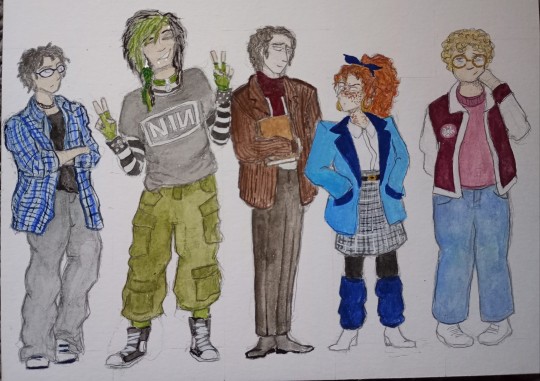
this is the whole piece btw, it's all the characters as teenagers
#it's 2002 thea 2005 mac 1984 falk 1983 nadia and 2004 alexander#i did a lot of research on youth fashion for this please appreciate it#scene mac and eighties nadia live in my head rent free fr#i love them so much#c: thea#c: makarius#c: falk#c: nadia#c: alexander#wip: rural fantasy#sol writes#sol draws
3 notes
·
View notes
Text
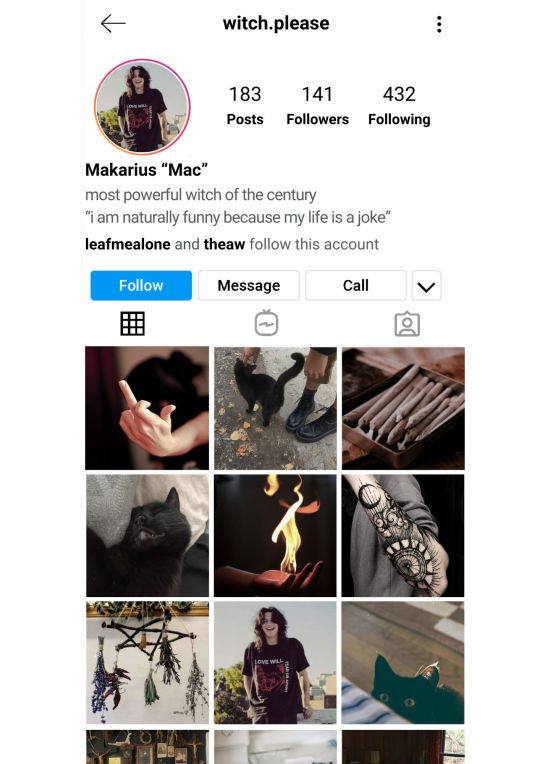

2 notes
·
View notes
Text
random idea of the day:
after the event of the novel, Makarius drags Falk into hosting a podcast where they meet every week and geek out about magic phenomenons.
it's called The Wizard, The Witch and The Wardrobe because they are recording crammed into a wardrobe for optimal sound conditions (Makarius read this online somewhere. Falk still has doubts. and back pain.)
Waschlappen stars as a special guest in most of the episodes and quickly becomes a fan favourite
after twenty episodes (and an intervention from Falk's chiropractor) they start recording outside of the wardrobe and consequentially rename the podcast to The Wizard, The Witch and The Waschlappen
2 notes
·
View notes
Text
Makarius and Falk are really 'unstoppable force meets immovable object' huh
5 notes
·
View notes
Text
okay so i've been chewing on the Falk/Makarius relationship for a while... like, in the first draft, Falk doesn't like Makarius and sees having to work with him as a punishment, which of course makes for a really fun dynamic, because Mac is super motivated and super tone deaf to Falk's disapproval of him
however, this doesn't really work anymore for the new draft, since Makarius brings himself into the investigation instead of being put there by Nadia, so Falk not wanting him there doesn't make a lot of sense anymore - if he wanted him gone, he could just kick him out.
obviously Falk is still not a fan of Mac's brash and loud and chaotic vibe, but i've been thinking that maybe he is fascinated by the fact that he is a witch and has so much magic power, so he is interested in Mac in a 'i want to study him in a lab' way? maybe he is excited to work with him because he never met a witch before and is thrilled by the new opportunity? also they are both basically magic nerds, so maybe Falk likes finally having someone to talk to who knows his curses and magical creatures without an half-hour lecture beforehand?
#so many possibilities#rotating them in my mind today#c: makarius#c: falk#wip: rural fantasy#sol writes
1 note
·
View note
Photo
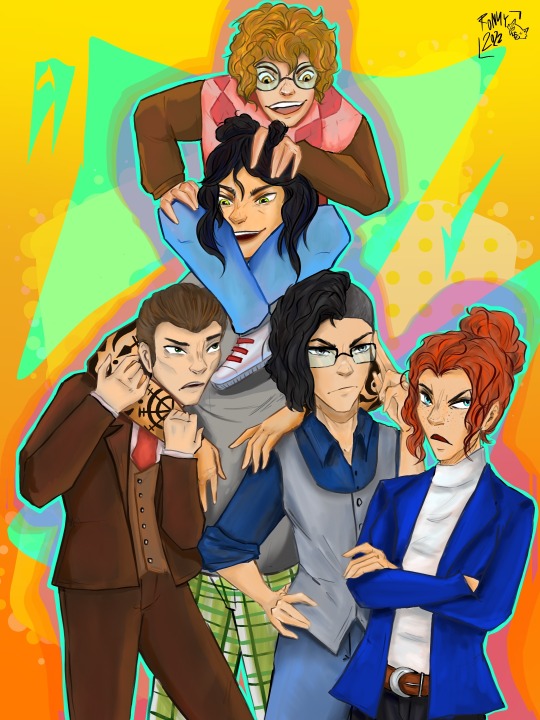

Okay so my extremely talented friend @ronald-to-die did this commission of the Verfluchtes Land Squad for me and... it is so good???? The sheer chaotic energy this radiates is truly unparalleled.
#the vibes... immaculate#they are all perfect but nadia the most if i dare say it#wip: rural fantasy#c: dorothea#c: makarius#c: falk#c: nadia#c: alexander#sol writes#also go check out her other artwork its dope i promise
8 notes
·
View notes
Text
Okay, hear me out:
✨Verfluchtes Land squad, but as a DnD party.✨
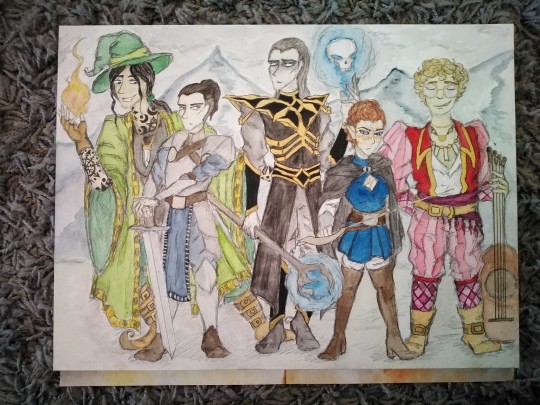
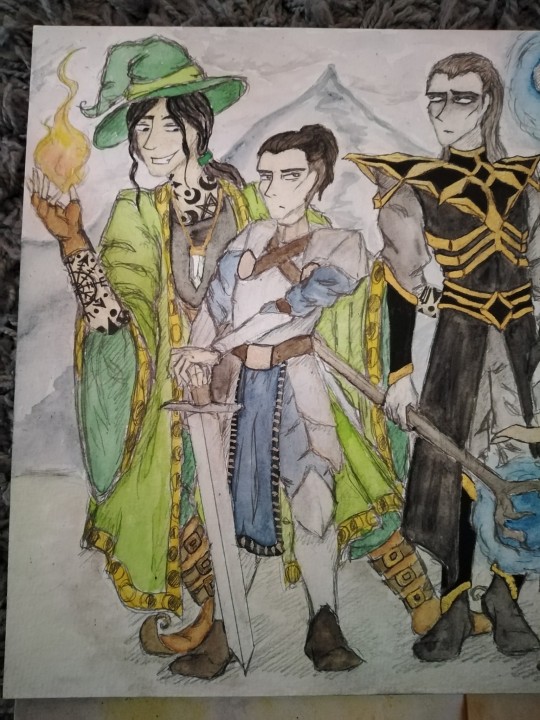
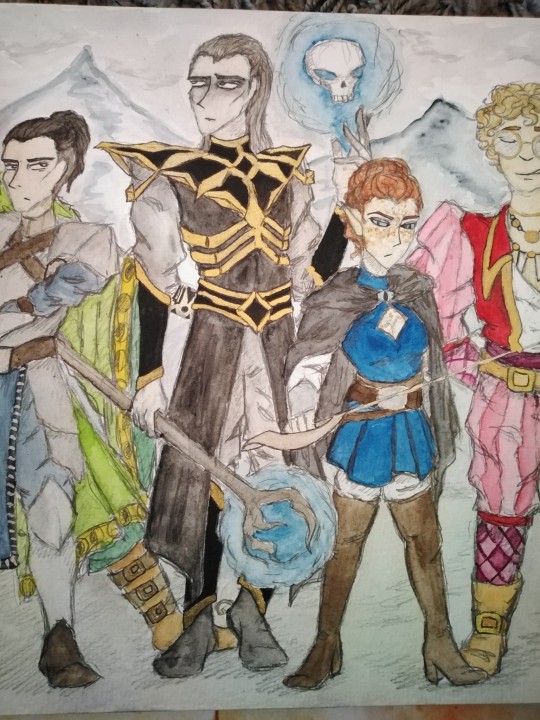
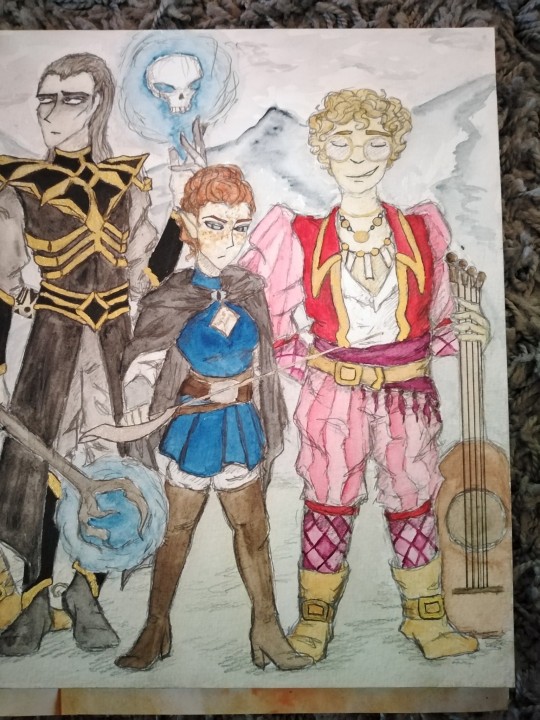
(Makarius is a sorcerer, Thea is a paladin, Falk is a wizard, Nadia is a rogue and Alexander is a bard)
#wip: rural fantasy#c: dorothea#c: makarius#c: falk#c: nadia#c: alexander#sol writes#or rather#sol draws#i LOVE how this turned out especially with the background#i am also in love with Falks design he's so edgy#they are amazing okay???#i love them so much
6 notes
·
View notes
Text
Work in Progress:
Rural Fantasy Adventure

Feeling a bit lost, Dorothea walked down the hall to find her new department. As she had already feared before, it was located in the furthermost corner of the building. Of course.
After a nice morning stroll over the entire second floor she found the right hall at last, with a bit of help from the exceptionally friendly secretary of the anti-fraud department.
Department for Cases with Magical Involvement, an already slightly faded sign next to a big wooden door said, and below that another, Superintendent for Cases with Magical Involvement Falk S. Ebenroether/Criminal Inspector Fabian Tobel, and another one below that, Alexander Boehm.
She sighed. So this was where she had ended up after all. Welcome to the lowest rung of the career ladder.
Then she knocked at the door.
Summary
Dorothea Wagner has anything but good luck. First she gets displaced to her despised old hometown, then demoted to work for the Department for Cases with Magical Envolvement, lovingly called Department of Hocus Pocus in-house, and on top of that she gets assigned a mysterious double homicide where all things seem to unkindly remind her of her own messy family situation.
To make matters even more complicated, she has to move in with a chaotic stoner, who turns out to have magic powers, and her sullen desk person colleague frequently gets himself headfirst into dangerous situations and consequently into trouble with the no-nonsense head of department who seems to have an extra strict eye on him.
And even the case that seemed boring and easy at first gets more and more complicated the more Dorothea gets into it and with every passing day she gets deeper into a swamp of messed up family dynamics, hate, jealousy and powerful magic...
Genre
contemporary fantasy, detective drama, comedy
Setting
the rural south of Germany where the magic of old folktales is alive and part of everyday life
Themes
family | friendship | magic | guilt, atonement, retribution and forgiveness | finding oneself | love | queerness | home
Characters
Thea | Makarius | Falk | Nadia | Alexander | Charlie | Seewald
Status
working on the third draft
#wip: rural fantasy#c: dorothea#c: makarius#c: falk#c: nadia#c: alexander#c: charlie#c: seewald#sol writes#wip intro#writeblr#this will be updated as i go on
29 notes
·
View notes
Note
2 & 6 for the writing ask? :)
2. Tell us about what you’re most looking forward to writing – in your current project, or a future project.
There are several scenes from my big novel project I am really looking forward to! Especially some of the scenes from the big showdown I don't want to spoil here! But they are going to be so cool! And epic! I can't wait!
There's also one scene that's coming up soon in which Falk and Makarius, my two favourite characters who don't like each other that much in the beginning, get roaringly drunk at their office at night and tell each other their big emotional secrets, it's going to be such a good scene and I love Falk and Mac so much it's unreal!!
Another scene I look forward to, from a completely different universe - an ASoIaF fanfiction that takes place in an Cold War AU partly inspired by The Americans (it only gets wilder from there lol). There's a scene where the main couple - two secret agents pretending to be a married couple who are secretly in love with each other but don't dare to tell each other to not strain their professional relationship - make out to hide their suspicious behaviour from a nosy neighbour. It has so many complicated feelings, it is funny and heart-wrenching at the same time, or at least I hope it's going to be. I can't wait!!
6. What character do you have the most fun writing?
I love all five main characters from my WIP: Rural Fantasy all the same, but every scene with Makarius is just a special delight because he is so unhinged and bold and always brings in a comedic and light-hearted element, and I love to write that, but I also like that he has also a lot of depth as a character. Mac just makes me happy!
Another favourite of mine is Rona, from my fanfiction universe. I love to write her because she is just cool and writing her constantly sassing her partner is very enjoyable.
#thanks for asking!💕💖#sol writes#wip: rural fantasy#c: falk#c: makarius#c: rona#alcohol tw#sol answers
4 notes
·
View notes
Text
Character Introduction: Makarius "Mac"

Name: Makarius Schwegelin
Age: 32
Occupation: none
Makarius, who prefers to go by "Mac", is one of the main protagonists of my WIP: Rural Fantasy.
He's a laid-back and funny guy who just kind of goes with the flow. He occasionally smokes weed for recreational purposes and likes all kinds of plants as well as medieval folk metal. Mac may seem lazy and careless at the first glance, but underneath his outward goofyness he hides a lot of insecurities.
Mac lives alone (save for his grandma) in Weiheroed, a huge old farmhouse that lies secluded in the woods next to small lake. After his parents moved to Argentina for business purposes some months ago, they left him not only the estate, but also a good chunk of money as well as his beloved car, a dark green 1998 Ford Mondeo Turnier.
Because he has enough money to cover his bills, he does not work regularly and just hangs around the house most of the times either gardening or trying out magic. Makarius' parents are both from powerful witch clans and he inherited their powers, but because he lacks discipline and training, his attempts at magic usually end in accidents that range from mildly funny (he gave his cat the ability to speak) to pretty dangerous (he set the entire garden on fire).
In the beginning of the story, he decides to rent out half of his house and takes in Thea, who is sick of living with her family.
See the others here: Thea | Falk | Nadia | Alexander | Charlie | Seewald
3 notes
·
View notes
Note
11, 19, 25 ^^
Sorry, I kind of totally forgot about this ask... but better late than never.
I'm going to answer this for the OCs from my current story project, I hope you don't mind.
11: What was the best gift your OC ever received?
Thea's circle of friends invited her to celebrate with them at their cabin in the mountains the first year after she moved out from her family. They also bought her a cup that reads I'm the rainbow sheep of the family and has a cartoon drawing of a sheep on the other side, which Thea holds in very high esteem.
Makarius' parents passed his beloved car (a green 1998 Ford Mondeo) on to him before they left for Bolivia. It's still his favourite possession.
Falk has a pocket watch Nadia got him. It's golden and has a renaissance painting showing a forest as the dial.
Nadia owns a jewellery set made of silver and sapphires that Falk had custom made for her as a present. She never wears it anymore, but can't bring herself to give it away, because it perfectly fits her taste and she actually loves it.
Alexander has the first scarf his niece knitted herself. It's not exactly a well-knitted scarf, but she put a lot of effort into it and it's cute.
19: Your OC goes ice skating. How well do they do?
Alexander and Nadia both do pretty well; Alexander because he goes ice skating regularly, Nadia because she used to do figure skating when she was younger and you don't forget things like that.
Thea does okay after a while of warming up.
Makarius is a chaotic force to be reckoned with, he is bad at it, but that doesn't keep him from going extremely fast and he falls on his face quite a lot.
Falk refuses to don skates or go on the ice, he says he's too old and his bones are to fragile for this, but he probably just tries to preserve his dignity.
25: What is your OC’s favorite Christmas carol or winter-themed song?
I answered that already in another winter themed ask set, so I just copy&pasted the answer from there!
Thea says she doesn't have a particular favourite holiday song, but she kind of likes Jingle Bell Rock and now and then catches herself whistling it while driving home or to work.
Makarius favourite christmas song is Willkommen in der Weihnachtszeit by Saltatio Mortis, which he blasts around the house all December long and he gets on every single of Thea's nerves with it.
Nadia's favourite is The Herald Angel Swing, a jazz arrangement of a traditional carol, because she loves jazz and it was her favourite piece to play with her old jazz band.
Falk hates christmas pop music and is very vocal about it, but he likes the solemn tunes of christmas carols used in church service (although he doesn't go to church services). His favourite is Silent Night, because it was his mother's favourite carol and reminds him of his childhood.
Alexander's favourite christmas song is unfortunately (and completely unironically) Wham!'s Last Christmas, which makes the entire office hope christmas time will be over soon, because nobody apart from him can stand it. (Makarius shows him the Saltatio Mortis cover of it and they take turns playing it, while Falk and Thea are secretly plotting a double homicide.)
#thanks for asking!💕💖#again sorry i'm so late#wip: rural fantasy#sol writes#c: dorothea#c: makarius#c: falk#c: nadia#c: alexander
3 notes
·
View notes